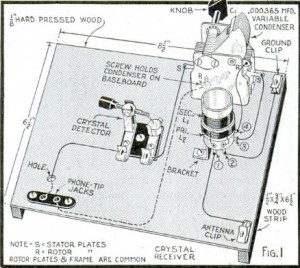 The young man shown here, now in his early 90’s, is pulling in a strong local broadcast station with the help of a simple crystal set shown in the August 1938 issue of Popular Mechanics.
The young man shown here, now in his early 90’s, is pulling in a strong local broadcast station with the help of a simple crystal set shown in the August 1938 issue of Popular Mechanics.
That, by itself, isn’t particularly remarkable, since a lot of kids constructed a crystal set. But this young man has the added satisfaction of knowing that within a month, he’ll also be pulling in the weaker stations, and he’ll get loudspeaker volume on those strong stations, when he upgrades the set. The construction article is actually a two-part article to be continued in the September issue showing two upgrades for the “progressive” receiver.
The first upgrade will replace the crystal detector with a tube. A few additional parts will be required, but thanks to careful planning, all of the original parts (with the exception of the 12 cent detector) will be re-used.
 And as soon as he gets the one-tube broadcast set going, he’ll be able to get to work on the final upgrade, which will allow him to pull in the short waves by adding a few parts. The original wooden chassis will be used for all three receivers.
And as soon as he gets the one-tube broadcast set going, he’ll be able to get to work on the final upgrade, which will allow him to pull in the short waves by adding a few parts. The original wooden chassis will be used for all three receivers.
As you can see from the pictorial diagram, the crystal set is a very basic model. The only interesting angle is that the antenna coil features a primary that can be adjusted by sliding it over the secondary, allowing the set to be peaked for the maximum sensitivity. When the set is upgraded (using an RK-43 tube), the primary coil becomes the tickler coil of a simple regenerative receiver, with the other half of the tube serving as audio amplifier. The upgrade to shortwave isn’t shown, but we promise to include it in a later post.
